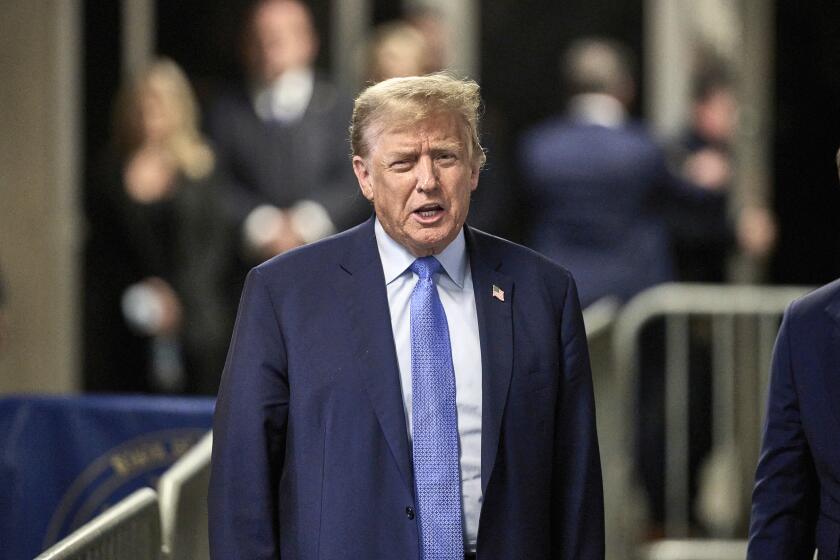India Battles to Protect Its Antiquities
The shipping container sat in one corner of New Delhi’s sprawling international airport awaiting customs clearance. It carried an innocuous-looking label: handicrafts.
Acting on a tip, customs officers opened the container and found not cheap carvings or tie-dyed cloth, but 18 stone statues more than 100 years old. They were valued at 40 million rupees, about $1.1 million.
The shipping documents carried fictitious names and addresses, but interrogation of the clearing agent led to the arrest of three people involved in the attempt to smuggle antiquities out of the country, officials said.
That discovery four years ago was the last major victory in the battle to keep India’s heritage at home.
For the most part, experts say, officials can do little to stop art thieves lured by big money overseas. Few connoisseurs in impoverished India could afford the stone treasures labeled “handicrafts.”
There aren’t enough guards to keep an eye on the antiquities in the Hindu temples and Muslim mosques scattered across this vast country. Unscrupulous traders often are helped by customs officials willing to look the other way for bribes.
The pillage of Indian art treasures has been going on for decades, but it recently came into the spotlight with the publication of Peter Watson’s new book, “Sotheby’s Inside Story,” which deals with smuggled antiques finding their way to the London auction house.
*
The book recounts how the residents of an Indian village awoke one night nine years ago to the sounds of thieves plundering the village temple. They gave chase, but the thieves escaped in the darkness.
One of the idols spirited away, a goat-headed goddess made of sandstone that was at least 1,000 years old, later surfaced at a Sotheby’s auction.
The idol, priced around $15,000, was withdrawn from the sale, but it has yet to be returned to the temple in Lokhari, a village near the holy city of Allahabad, 400 miles southeast of New Delhi.
“We do take Watson’s allegations of complicity in the handling of smuggled Indian antiquities extremely seriously, and Sotheby’s has launched a major internal investigation--to be conducted by external lawyers--[that] will certainly examine this area,” said Simon Taylor, a Sotheby’s spokesman.
India’s foreign ministry says it seeks the return of every smuggled antiquity it learns about. The government waged a nearly 10-year-long legal battle in Britain to recover a stolen statue of Lord Nataraj, a Hindu god, valued at $2 million.
The theft came to light in 1982, when an alert employee of the British Museum went to the Indian Embassy in London with his suspicions that the statue was stolen property. The 3-foot-tall statue had been purchased by a Canadian oil company from a Briton of Indian or Pakistani origin for $250,000 and sent to the museum for restoration.
*
The 11th-century statue, found by two laborers digging on the grounds of an abandoned temple in the southern Indian state of Tamil Nadu in 1976, had been missing since shortly after its discovery. The Indian government sued the oil company and got the statue back in 1992.
“For the first time in living history, an item which has been smuggled out of the country and sold in a foreign market as an antique has been returned to the country of origin under a court order,” said Sunita Mainee, an attorney who argued India’s case in court.
India’s Antiquities and Art Treasures Act of 1974 prohibits the export any object more than 100 years old and requires all such objects be registered with the Archeology Survey of India. Violators can be jailed for as long as six years.
“We have declared nearly 5,000 monuments as the protected ones in India, and these are being guarded by [the Archeology Survey],” said Hari Manjhi, a director of the agency.
But he conceded there are vast unprotected areas holding thousands of temples in nearly half a dozen Indian states, notably Tamil Nadu in the south and Assam in the northeast.
Poor villagers and former princes, who own an abundance of antiques and old art but have no source of income, sell off pieces to make a living, art dealers say.
Corrupt customs officials and police help smuggle art out to foreign dealers and Western collectors in return for cash. Meanwhile, honest agents have time to examine only 10% to 15% of the freight leaving through the country’s sea and airports.
And even when the art guardians score a victory, ordinary Indians do not necessarily benefit.
Four years after being discovered at the airport, the 18 stone statues remain in a warehouse. Officials have yet to arrange for their display in a museum.
More to Read
Start your day right
Sign up for Essential California for news, features and recommendations from the L.A. Times and beyond in your inbox six days a week.
You may occasionally receive promotional content from the Los Angeles Times.






